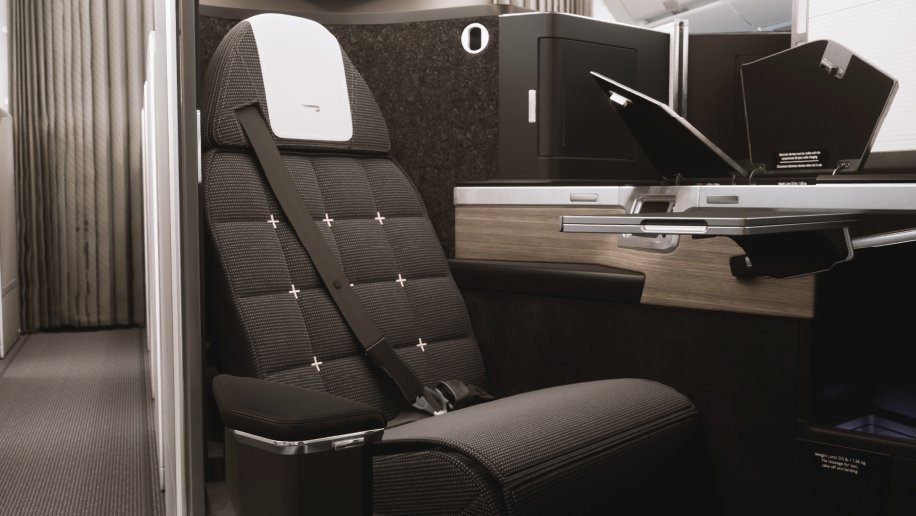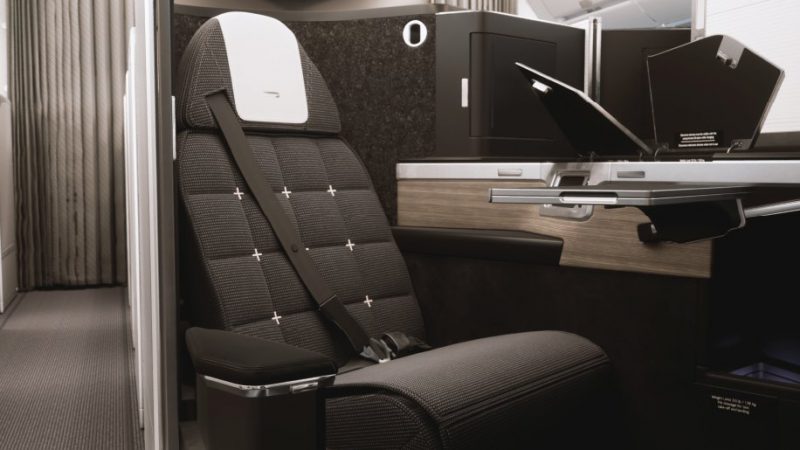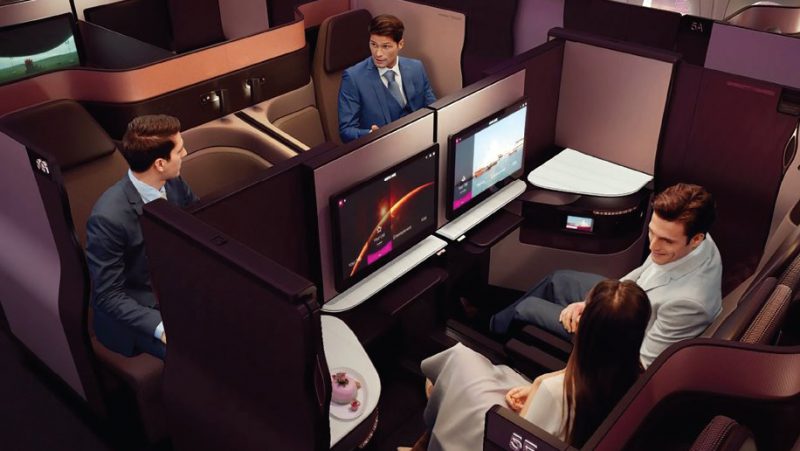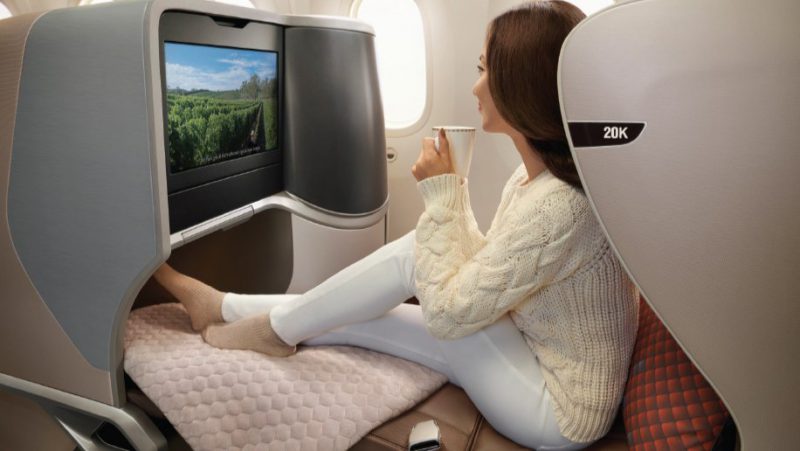Betting on Business Class
Airlines up the ante for those profitable premium fliers at the pointy end of the plane
October 26, 2019


It’s no secret that business travelers make up 12 percent of the revenue passengers on most carriers. But this tiny group accounts for as much as 75 percent of airlines’ profits. Corporations are usually willing to pay more for their fliers to get where they are going and often accept the booking of last-minute flights and non-stops — not to mention front-of-the-plane seats — as the cost of doing business.
To that end, airlines are rewarding those premium fliers with lounge perks, culinary upgrades and even chauffeured airport transport, ever competing to win the hearts and minds of that small pool of premium fliers.
However, trends afoot point to a shift in thinking by airline companies. Airlines are experimenting with eliminating first class cabins, expanding premium economy and unbundling the perks of Business Class flying to reach a wider, more budget-conscious clientele and bring them into the forward cabin fold. Once you have flown Business Class, the back of the plane often becomes a distant memory.
Most recently the viability of First Class seating has come into question, with such airlines as Korean Air, Asiana, Malaysian Airlines, British Airways and Cathay Pacific experimenting with eliminating the class on many flights – or altogether.
At the same time, such luxury carriers as Emirates and Lufthansa are trying out concepts in “unbundling” or shaving off perks and benefits of upgraded travel in an effort to make the Business Class seat more affordable to people who would otherwise not book the bump.
“First Class is still a very important product for premium airlines serving the most lucrative markets,” says Gary Leff, who runs the popular airline industry blog, View from the Wing. He maintains, “First Class matters at London Heathrow, Hong Kong, Singapore, Dubai and New York JFK. It matters for Singapore Airlines, Lufthansa and Emirates. What we’re seeing is that not all airlines can compete in this space, and there are a limited number of seats that sell in a limited number of markets. Where it makes sense is where you’ll find passengers who trade down from flying private given the distance.”
Most airlines, however, are upping the ante on flying Business Class with bigger seats, better entertainment, more comfortable sleeping arrangements and refined culinary offerings. With fares that can run into five digits for a single roundtrip flight, keeping the passengers happy at any cost is a top priority.
 Suite Spot
Suite Spot
Qatar’s Airway’s Qsuite is one of those distinctive product ideas that allows carriers to ask “what if?” – as in, what if we switched out our First Class seats in favor of something that favors couples and families. The Qsuite is a ‘quad’ suite where four people traveling together can open up their seats to be able to face each other.
The suite is little more than two sets of middle row seats facing each other. They can be separated as well by entertainment screens. The seats can melded together into a comfy couple’s space (no, this is not the seat to book if you are traveling with work colleagues and want some privacy) or open up into a table for a family meal. The suite is flanked by closable doors so a couple can wine, dine, watch movies and sleep together in a strange kind of public/private comfort. Still, the doubled to quadrupled space feels large and allows for a tad more onboard seclusion and intimacy for two or four.
British Airways recently introduced its new Club Suite on its flights from Toronto to London and beyond, decking out its new A350s (and retrofitting some 777s) with a redesigned Business Class cabin with luxurious flat-bed seats and direct-aisle access in a 1-2-1 configuration.
Each of the new Club Suite seats features a sliding privacy divider to create a sense of being in your own private cocoon. The compartments hold 40 percent more storage, feature a vanity unit and mirror, present 18.5-inch Panasonic high definition touch screens with gate-to-gate programming, keep-running WiFi access and PC / USB power ports.
Not to be one-upped, Virgin Atlantic recently unveiled its new Upper Class business seat on the Airbus A350-1000s, which flew its inaugural flagship route between London Heathrow and New York JFK in September. The airline incorporated 44 seats in Upper Class with 11 rows of four seats across, all with direct aisle. Each seat is 20 inches wide, has 44 inches of pitch, and reclines to an 82-inch flat bed, making it one of the longest lie-flats in the air.
In true VA form, passengers can arrange to collect personalized sets of pajamas to don onboard. They can also enjoy sleeping on a thick mattress pad with a soft duvet and full-size pillow. Bored passengers can leave their seats to occupy The Loft. This is a comfy little booth that seats six and features a 32-inch HD monitor as well as standing workstations.

US Business Class Concepts
Singapore Airlines offers one of the top Business Class seats in the sky with its 29-inch-wide bay that has a 60-inch pitch and transforms into a 78-inch lie flat bed. This writer walked onto a competing airline recently to take a Business Class seat and accidentally sat in First Class instead — as that airline’s First Class seat was the same as SIA’s A350-900 Business Class seat; the confusion stemmed from a trip on Singapore Air only two weeks previous.
Singapore Air also allows Business Class fliers to Book the Cook with some pre-trip planning and enjoy a celebrated meal designed by such acclaimed chefs as Alfred Portale, Georges Blanc, Susan Goin and Mathew Moran.
LATAM Airlines Group just launched its new Premium Business product onboard its Boeing 777 aircraft. All seats in this cabin come with direct access to the aisle. The lie-flat seats are complemented by pajamas, premium pillows and mattresses of temperature-regulating materials and pressure-point technology. All Business Class seats also come with their own 18-inch Panasonic inflight entertainment screen and lots of stowage space.
Along with the new seats, Business Class passengers can look forward to LATAM’s new culinary concepts. The airline group is spending half a billion dollars to boost its premium product (the airline group is retrofitting around 200 planes in its global long-haul fleet over the next two years) and that includes a menu crafted by Chilean and Brazilian chefs complemented by sommelier-curated South American wines.
American carriers are not usually lauded for their premium class comforts but United has been busy trying to change that. United is in the midst of a multi-year upgrade, increasing the number of premium seats on 777-300s (and some 200s) by 50 percent this year to 50 business-class seats (verses 37 and 28 on other US legacy carriers). It has been rolling out a Polaris-branded Business Class experience on its 767s to Europe and Asia (with 46 Polaris Class seats), coupled with wowing new lounges at SFO, EWR, IAD, IAH and ORD.
The revamped cabin service includes Saks Fifth Avenue bedding, Sunday Riley skincare amenity kits, and Zodiac Aerospace seats with aisle access that transform into lie-flat beds. A mattress pad and temperature managing gel pillows add to the comfort.
“There’s certainly hope for the three major US carriers. In the last several years, each of them (American, Delta, United) have invested millions of dollars in rolling out competitive products,” says Nick Ellis, Reviews Editor at ThePointsGuy.com.
“On the seat side of the equation, they’ve done an admirable job, with American having brand-new Casper bedding and modern lie-flat seats fleetwide, Delta transitioning to an enclosed-suite product on most of its long-haul fleet (the Boeing 767s will get an updated seat, but without a door), and United is in the middle of installing its unique-for-United Polaris product across its long-haul fleet.”
Flying into the Future
While some say airlines are headed to an unbundling concept and the dumbing down of the Business Class experience to reach a wider market of “base fare” fliers, seat designers and airline industry spinners are seeing even more choice and more luxury at 30,000 feet. What does that look like?
According to a Wall Street Journal interview with John Tighe, director of design for transport at London-based JPA Design, “active cabins” and “sleep cabins” may be in the offing, transforming cargo holds into comfortable sleeping pods below the main deck where premium passengers can retire from their main deck seat. If what airlines sell you is essentially the possibility of a good sleep, “You could consider a Business Class ticket the most expensive sleep of your life,” he says.
Aviation industry analyst Ben Bettell, believes Business Class will continue to grow at the expense of First Class, and premium economy will continue to edge out economy seats.
“At the moment there are only 31 airlines flying real First Class – and many of those airlines are reducing their cabin size for First Class. There is a very limited market flying what we would call Super First Class,” he said in a blog interview earlier this year.
New classes of service that we have yet to see could be introduced as gaps between Business Class and economy class widen. Other changes may come in the shape of “zones,” such as experience zones, quiet zones, luxury zones and family zones.
Adding to this, Ellis believes those quasi-enclosed spaces in Business Class will begin to pop up on airlines like kale salads at family buffets. “I believe we’re going to see a proliferation of fully enclosed spaces in the Business Class cabin, with connected suites that will allow greater customization for your entertainment options,” he says.
“We’re also sure to see more ‘collaborative’ cabins, thanks to airlines including spaces that allow passengers to socialize or even have a meeting at 35,000 feet. Further off, we may even see aircraft equipped with full gyms for people who want to keep active on an ultra-long-haul flight.”




